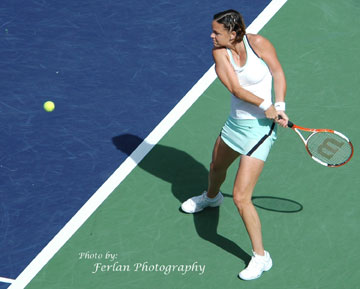Players today are taught to hit the ball hard and move well enough to get to balls that are hit hard.
 The first thing that’s wrong with the women’s tennis tour is that the WTA is trying its best to knock Lindsay Davenport off the tour. Larry Scott, the CEO of the WTA, refused to give Davenport a wild card for and upcoming Tier I tournament in Zurich. In an article in the New York Times this week Davenport is quoted as saying, “He’s trying to get me out of the game, that’s how I feel.”
The first thing that’s wrong with the women’s tennis tour is that the WTA is trying its best to knock Lindsay Davenport off the tour. Larry Scott, the CEO of the WTA, refused to give Davenport a wild card for and upcoming Tier I tournament in Zurich. In an article in the New York Times this week Davenport is quoted as saying, “He’s trying to get me out of the game, that’s how I feel.”
This is the third time this year that Scott has refused to give Davenport a wild card. In each case Davenport didn’t enter the tournament by the deadline because she had injuries and wasn’t sure she could play. It’s a catch-22 for her because Scott is penalizing players for pulling out of tournaments thus leaving tournaments with weak fields. [blockquote?]If Davenport had entered then withdrew she would have been penalized, if she waited till the injury healed and missed the entry deadline, she couldn’t get a wild card.
Davenport is a three time grand slam winner with fifty-one singles titles who is close to setting the record for career prize money on the women’s tour. She’s in her last playing days and she’d never tolerate an Andre Agassi style retirement tour, so do the next best thing: let her play when and wherever she wants and welcome her with open arms.
As for the rest of the women on the tour, reader Matt eloquently expressed dismay at the poor level of play in the opening round matches of the U.S. Open. He was astonished to watch players hit up to eleven or twelve errors for every winner and it irked Matt who preferred the days when Chris Evert, Martina Navratilova, Steffi Graf and Monica Seles kept the ball in the court and played with “Point-plotting that rivaled that of a Victorian novelist for patience and thoroughness.” See what I mean about eloquence.
I’ve been grousing about the women’s tour for some time and trotted out my reasons for its demise: injuries related to the added power of rackets and the long and increasingly global schedule with a paltry off-season, increased competition due to the astounding increase in Eastern European and Asian players, longevity problems because women turn pro at such a young age. But Matt wasn’t buying it.
He is certainly correct that current players don’t compare with those former queens of tennis when it comes to strategy. That’s why Martina Hingis could come back after a three year rest and land in the top ten within eight months. She still can’t hit the ball hard but she can out-think most players. And women’s tennis at the top today is decidedly inferior. There were, embarrassingly, three bagel sets in the women’s U.S. Open semifinals alone, wow that looks bad.
Matt blames the players for paying attention to their marketing image more than their tennis. Sharapova is the highest paid female athlete in the world and has only one slam to her name. Michelle Wie is sixteenth on the income list for all golfers, male and female, and she has yet to win a tournament. We can probably blame Nike and Michael Jordan for that. But I can’t knock Sharapova or Wie’s work ethic though I would like Sharapova to develop a better all-round game and I might like Wie to win something, anything, before she plays those European men’s tournaments.
No, I have to blame the power game. Players today are taught two things: hit the ball hard and move well enough to get to balls that are hit hard. And if you’re Lindsay Davenport, you don’t even have to move well, you just have to hit a winner before your opponent does. Certainly Roger Federer can be a finesse player but when he plays Rafael Nadal, he makes a lot of errors. He doesn’t worry about them because he knows that he has to go for more winners to get the ball past the speedy Nadal.
Women will adjust to the speed and power in the game and a dominant female player (or players) will eventually come along. Until then, join the rollercoaster ride.
See also: The WTA and Davenport: biting the hand that feeds you.